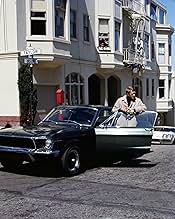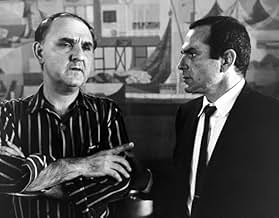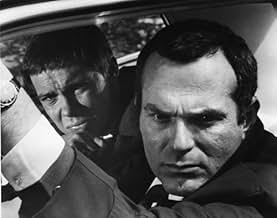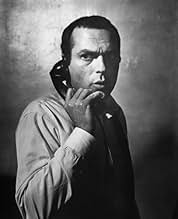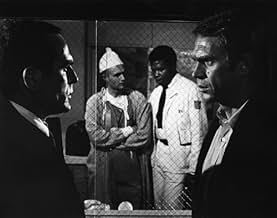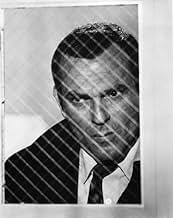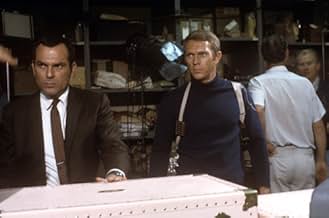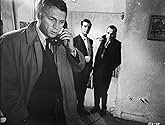Un policía de San Francisco con agallas pero sin gloria está decidido a encontrar a un cabecilla del hampa que asesinó al testigo que estaba bajo su protección.Un policía de San Francisco con agallas pero sin gloria está decidido a encontrar a un cabecilla del hampa que asesinó al testigo que estaba bajo su protección.Un policía de San Francisco con agallas pero sin gloria está decidido a encontrar a un cabecilla del hampa que asesinó al testigo que estaba bajo su protección.
- Dirección
- Guionistas
- Elenco
- Ganó 1 premio Óscar
- 7 premios ganados y 9 nominaciones en total
Vic Tayback
- Pete Ross
- (as Victor Tayback)
- Dirección
- Guionistas
- Todo el elenco y el equipo
- Producción, taquilla y más en IMDbPro
Opiniones destacadas
Steve McQueen's career peaked in 1968 with "Bullitt" and "The Thomas Crown Affair," both ideal vehicles for his cool persona. Although superior to its recent remake, "Crown" has not aged gracefully, while "Bullitt" has held up fairly well.
Cool though he may be, Frank Bullitt is a totally committed detective, perhaps even more so than Gene Hackman's Popeye Doyle or Clint Eastwood's Dirty Harry Callahan. Bullitt is a complete professional who never takes his eye off the objective, no matter how much interference he encounters from his superiors or from Robert Vaughan's scheming politician, Walter Chalmers. And Bullitt, unlike Doyle or Callahan, operates without the histrionics. No one-liners, no yelling and screaming tantrums from this officer. You may not like him very much, but you have to respect his dedication to duty and you'll quickly share his absolute contempt for Chalmers.
"Bullitt" is best remembered for its spectacular car chase in which McQueen reportedly did most of his own driving. But this is not primarily an action film. Aside from the chase and the final shootout at SFO, there's not a lot of violence. Most of the attention is on Bullitt's maneuvering to unravel the mystery and to keep Chalmers off his back.
Recommended if you like McQueen or policiers in general. The pace may be a little slow for people under 30 who are used to a more slam-bang, less cerebral approach to this sort of thing, but "Bullitt" is still worth your time. Just don't expect "Lethal Weapon."
Cool though he may be, Frank Bullitt is a totally committed detective, perhaps even more so than Gene Hackman's Popeye Doyle or Clint Eastwood's Dirty Harry Callahan. Bullitt is a complete professional who never takes his eye off the objective, no matter how much interference he encounters from his superiors or from Robert Vaughan's scheming politician, Walter Chalmers. And Bullitt, unlike Doyle or Callahan, operates without the histrionics. No one-liners, no yelling and screaming tantrums from this officer. You may not like him very much, but you have to respect his dedication to duty and you'll quickly share his absolute contempt for Chalmers.
"Bullitt" is best remembered for its spectacular car chase in which McQueen reportedly did most of his own driving. But this is not primarily an action film. Aside from the chase and the final shootout at SFO, there's not a lot of violence. Most of the attention is on Bullitt's maneuvering to unravel the mystery and to keep Chalmers off his back.
Recommended if you like McQueen or policiers in general. The pace may be a little slow for people under 30 who are used to a more slam-bang, less cerebral approach to this sort of thing, but "Bullitt" is still worth your time. Just don't expect "Lethal Weapon."
The late 1960s saw two classic, hard-boiled thrillers set in San Fransico; John Boorman's stylised 'Point Blank', and Peter Yates' 'Bullitt'. Calling your hero Bullitt might seem an unsubtle way to emphasise his macho qualities, but in fact Steve MacQueen plays him as a quiet man, not some wise-talking maverick: he does what he has to do, but takes no pleasure in his actions; and survives the roughness of his work not by becoming a monster, but simply by becoming a little less human. It's a believable portrait, and the film as a whole has a procedural feel: there are action scenes, but these are kept in their place in the overall design.
Today, the film is most famous for its celebrated car chase, which makes excellent use, as indeed does the movie as a whole, of the bay area locations, but is not actually shot that excitingly: the conclusion at the airport is more original, though it roots the film in the time when it was permissible to take a loaded gun onto a plane. But overall this is still a classy film, dry, exciting and bleak, and among the very best films of its day. William Friedkin's brilliant 'The French Connection', made a short while afterwards, would appear to owe it a debt.
Today, the film is most famous for its celebrated car chase, which makes excellent use, as indeed does the movie as a whole, of the bay area locations, but is not actually shot that excitingly: the conclusion at the airport is more original, though it roots the film in the time when it was permissible to take a loaded gun onto a plane. But overall this is still a classy film, dry, exciting and bleak, and among the very best films of its day. William Friedkin's brilliant 'The French Connection', made a short while afterwards, would appear to owe it a debt.
What a change of pace this movie is as compared with its genre today. I'm no old fogey but would that modern directors become smart enough take several pages from its book.
The Bullit character is a precursor of Dirty Harry but a bit more cerebral. Stylistically, the director sets the stage beautifully for McQueen's Bullit. The movie has a European feel (director Peter Yates is a Brit) and achieves its dark mood through quiet understatement. The musical score for instance. Today, music is overly used, overly loud and manipulative. (i.e. in case you are not moved by this scene, here are a division of amplified violins to remind you to weep). In 'Bullit' the music is sparingly used and doesn't intrude at all. It complements the directorial style without setting the agenda.
The feeling of reserved naturalism is achieved through editing and dialogue. There really aren't very many lines in the movie and when characters do speak they are very succinct. Notice the last 15-20 minutes of the movie, most of which takes place at the airport. Hardly a line in it. There is none of the chattiness so prevalent today (especially post "Pulp Fiction") which is so tedious (unless the script is tip-top, which is rare).
Editing is, perhaps, its greatest strong point. The many long edits deserve equal credit with the dialogue in setting the low-key mood. The cinema verite dialogue of the airport scenes (and, say, the scene where McQueen and Don Gordon search the trunk) combined with the long cuts add greatly to understated feel while adding realism.
And the performances are top notch. The spare script helps McQueen shine since the taciturn moodiness fits his persona to a tee. There are very fine performances from all of the supporting cast, from Don Gordon to Bisset to Fell to Duvall to Oakland. This is a great movie for watching faces. Note the expressions of the hit men during the chase scene (just another example of this movie letting the little touches speak volumes).
The chase scene certainly deserves its billing as one of the best in movie history. Recently, 'The Transporter' was lauded for its opening chase sequence. The one in 'Bullit' is a marvel compared. In 'The Transporter' sequence I'm not sure there is a cut that lasts more than three seconds. In 'Bullit' it is again the editing which sets it apart here. The long edits give you the feel of acceleration and deceleration, of tire smoke and gears, of wind and the roller coaster San Francisco streets. You are given the time to place yourself in the frame. In short, 'Bullit' uses real craftsmanship. Films like 'The Transporter' use hundreds of quick edits to mimic the danger and immediacy of 'Bullit' but it comes across as hot air, confusion instead of clarity. The two scenes are perfect set pieces of easy (and hollow) Mtv-style flash versus real directorial substance.
The Bullit character is a precursor of Dirty Harry but a bit more cerebral. Stylistically, the director sets the stage beautifully for McQueen's Bullit. The movie has a European feel (director Peter Yates is a Brit) and achieves its dark mood through quiet understatement. The musical score for instance. Today, music is overly used, overly loud and manipulative. (i.e. in case you are not moved by this scene, here are a division of amplified violins to remind you to weep). In 'Bullit' the music is sparingly used and doesn't intrude at all. It complements the directorial style without setting the agenda.
The feeling of reserved naturalism is achieved through editing and dialogue. There really aren't very many lines in the movie and when characters do speak they are very succinct. Notice the last 15-20 minutes of the movie, most of which takes place at the airport. Hardly a line in it. There is none of the chattiness so prevalent today (especially post "Pulp Fiction") which is so tedious (unless the script is tip-top, which is rare).
Editing is, perhaps, its greatest strong point. The many long edits deserve equal credit with the dialogue in setting the low-key mood. The cinema verite dialogue of the airport scenes (and, say, the scene where McQueen and Don Gordon search the trunk) combined with the long cuts add greatly to understated feel while adding realism.
And the performances are top notch. The spare script helps McQueen shine since the taciturn moodiness fits his persona to a tee. There are very fine performances from all of the supporting cast, from Don Gordon to Bisset to Fell to Duvall to Oakland. This is a great movie for watching faces. Note the expressions of the hit men during the chase scene (just another example of this movie letting the little touches speak volumes).
The chase scene certainly deserves its billing as one of the best in movie history. Recently, 'The Transporter' was lauded for its opening chase sequence. The one in 'Bullit' is a marvel compared. In 'The Transporter' sequence I'm not sure there is a cut that lasts more than three seconds. In 'Bullit' it is again the editing which sets it apart here. The long edits give you the feel of acceleration and deceleration, of tire smoke and gears, of wind and the roller coaster San Francisco streets. You are given the time to place yourself in the frame. In short, 'Bullit' uses real craftsmanship. Films like 'The Transporter' use hundreds of quick edits to mimic the danger and immediacy of 'Bullit' but it comes across as hot air, confusion instead of clarity. The two scenes are perfect set pieces of easy (and hollow) Mtv-style flash versus real directorial substance.
With the possibly exception of Casablanca, I think this must be the film I've watched on TCM more than any other. I mean, I feel like I must catch it every time it airs, not intentionally, but I turn on my TV, and there it is. It's gotten where not only do I know how every scene unfolds in order, but I also almost feel like I could write down the action shot by shot without looking. And even so, I'm still not sure I understand the plot after all these viewings! The mobsters and informants are almost meaningless. They're just there to give Steve McQueen someone to chase and shoot.
The real conflict of the movie is between McQueen's Bulitt and Robert Vaughn's Chalmers (is Superintendent Chalmers, or "Super Nintendo Chalmers" as Ralph Wiggum once called him, named after this character?). The whole movie appears to be a set-up for the one moment McQueen can say BS to Vaughn when he suggests compromise is sometimes okay. Anyway, I love the '60s vibe. I love Jacqueline Bissette wearing only pajama tops and apparently sleeping nude. I love the view of the street from her breakfast nook (looks just like the view from the apartment Benjamin rents in The Graduate). I love the flute-led jazz combo at the restaurant (they're probably somebody real and famous, at least within jazz circles, but I've never learned who).
The real conflict of the movie is between McQueen's Bulitt and Robert Vaughn's Chalmers (is Superintendent Chalmers, or "Super Nintendo Chalmers" as Ralph Wiggum once called him, named after this character?). The whole movie appears to be a set-up for the one moment McQueen can say BS to Vaughn when he suggests compromise is sometimes okay. Anyway, I love the '60s vibe. I love Jacqueline Bissette wearing only pajama tops and apparently sleeping nude. I love the view of the street from her breakfast nook (looks just like the view from the apartment Benjamin rents in The Graduate). I love the flute-led jazz combo at the restaurant (they're probably somebody real and famous, at least within jazz circles, but I've never learned who).
Despite having aged somewhat, Bullitt remains a tough, gritty, and altogether realistic portrait of police life in late sixties San Francisco. The film is of course most renowned for the spectacular (even by today's standards) car chase in which star Steve McQueen famously did his own stunt driving (I wonder what the insurance policy was like?!) Although McQueen didn't really have to stretch beyond his already established screen persona, he is perfect in the role. He is Bullitt like Connery is Bond. Maybe the role was tailored specifically for him. He also has Jacqueline Bisset (Cathy), who can more than hold her own with any Bond girl, to come home to! She adds a welcome domestic quality and the audience feels relieved that despite the unforgiving profession Bullitt works in, at least he has a good woman at his side. The location photography in beautiful San Francisco, the to-the-letter accurate procedural dialogue, the political infighting with the smarmy D.A. Chalmers (Robert Vaughn) and the brutally violent action scenes all complement the fine performances to create an entirely engrossing authentic crime drama. Watch for the great Robert Duvall in a minor role as the cabbie.
¿Sabías que…?
- TriviaWhile filming the scene where the giant airliner taxis just above Steve McQueen, observers were shocked that no double was used. Asked if the producers couldn't have found a dummy, McQueen wryly replied, "They did."
- ErroresDuring the chase sequence, the same green Volkswagen Beetle is seen at least 4 different times in 4 different locations in a period of not more than 1 minute.
- Versiones alternativasDuring the car chase, when the Charger goes wide on a corner and hits a camera, the film was salvaged and red frames added at the end, to give a "point of impact" impression. Despite this gag being in situ for decades, on the current Cinemax Asia print, someone has seen fit to completely remove these last frames of the shot.
- ConexionesEdited into Ciudad en llamas (1979)
Selecciones populares
Inicia sesión para calificar y agrega a la lista de videos para obtener recomendaciones personalizadas
- How long is Bullitt?Con tecnología de Alexa
Detalles
- Fecha de lanzamiento
- País de origen
- Idioma
- También se conoce como
- Đại Tá Bullitt
- Locaciones de filmación
- Coffee Cantata, Union Street, San Francisco, California, Estados Unidos(jazz club and restaurant scene)
- Productora
- Ver más créditos de la compañía en IMDbPro
Taquilla
- Presupuesto
- USD 5,500,000 (estimado)
- Total en EE. UU. y Canadá
- USD 511,350
- Fin de semana de estreno en EE. UU. y Canadá
- USD 408,627
- 7 oct 2018
- Total a nivel mundial
- USD 512,162
Contribuir a esta página
Sugiere una edición o agrega el contenido que falta




